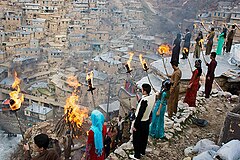
Back Newroz al Kurdistan Catalan نەورۆزی کوردەواری CKB Kurdisk fejring af Newroz Danish نوروز در میان کردها Persian Newroz Swedish
| Newroz نەورۆز | |
|---|---|
 Kurds celebrating Newroz in the village of Pallingan. | |
| Type | National, ethnic, international |
| Significance | New Year holiday |
| Date | Usually on March 21; but also 19 and 20. |
| 2023 date | Monday 20 March 2023 at 21:24 UTC * |
| 2024 date | Wednesday 20 March 2024 at 03:06 UTC * |
| Frequency | annual |
 |
Newroz or Nawruz[1] (Kurdish: نەورۆز, Newroz)[2] is the Kurdish celebration of Nowruz; the arrival of spring and new year in Kurdish culture. The lighting of the fires at the beginning of the evening of March 20 is the main symbol of Newroz among the Kurds.[3][4][5][6]
In Zoroastrianism, fire is a symbol of light, goodness and purification. Angra Mainyu, the demonic anti-thesis of Ahura Mazda, was defied by Zoroastrians with a big fire every year, which symbolized their defiance of and hatred for evil and the arch-demon. In Kurdish legend, the holiday celebrates the deliverance of the Kurds from a tyrant, and it is seen as another way of demonstrating support for the Kurdish cause.[7][8][9][10][11] The celebration coincides with the March equinox which usually falls on 21 March[12] and is usually held between 18 and 24 March. The festival has an important place in terms of Kurdish identity for the majority of Kurds.[7][8][10] Though celebrations vary, people generally gather together to welcome the coming of spring; they wear traditional coloured Kurdish clothes, dance together, light fires to dance around and jump over the bonfire, play Kurdish games.[13][14][3]
- ^ Thomas Bois, Connaissance des Students, 164 pp., 1965. (see p. 69)
- ^ Abdurrahman Sharafkandi (Hejar), Henbane Borîne (Kurdish-Kurdish-Persian Dictionary), Soroush Press, 1991, Tehran, p. 715
- ^ a b Ahmady, Kameel 2009: Another look at east and southeast Turkey. GABB Publication, Diyarbakır. p 248.
- ^ "Possible closure of political party dampens Nowruz for Turkey's Kurds - Al-Monitor: Independent, trusted coverage of the Middle East". www.al-monitor.com. 2022-03-29. Retrieved 2023-09-21.
- ^ "Nowruz celebrations in Turkey". Al Arabiya English. 2014-03-21. Retrieved 2023-09-21.
- ^ Plimmer, Joe (2023-03-21). "Nowruz: Kurdish new year 2023 celebrations – in pictures". the Guardian. ISSN 0261-3077. Retrieved 2023-09-21.
- ^ a b Murphy, Dan (2004-03-24). "For Kurds, a day of bonfires, legends, and independence". The Christian Science Monitor. Retrieved 2007-03-08.
- ^ a b Yanik, Lerna K. (March 2006). "'Nevruz' or 'Newroz'? Deconstructing the 'Invention' of a Contested Tradition in Contemporary Turkey". Middle Eastern Studies. 42 (2): 287. doi:10.1080/00263200500417710. hdl:11693/49511. S2CID 143682680.
- ^ Jupp, James (2001). The Australian People: An Encyclopedia of the Nation, its People and their Origins. Cambridge: Cambridge University Press. ISBN 0-521-80789-1.
- ^ a b Yildiz, Kerim; Fryer, Georgina (2004). The Kurds: Culture and Language Rights. Kurdish Human Rights Project. ISBN 1-900175-74-6.
- ^ Wahlbeck, Osten (1999). Kurdish Diasporas: A Comparative Study of Kurdish Refugee Communities (Migration, Minorities and Citizenship). Basingstoke: Macmillan. ISBN 0-312-22067-7.
- ^ "Newroz – Kurdish New Year". BBC.
- ^ Frantz, Douglas (2001-03-23). "Diyarbakir Journal: Where Misery Abounds, the Kurds Make Merry". The New York Times. Archived from the original on 2007-02-16. Retrieved 2007-03-08.
- ^ Macris, Gina (2002-03-25). "Kurds Ring in New Year". Providence Journal. Archived from the original on 2006-12-17. Retrieved 2007-03-08.